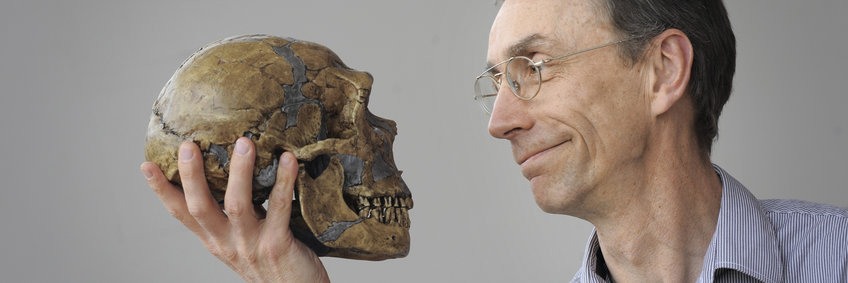
History of our evolution in a new light
The Neanderthals are alive - in us! The latest methods of investigation have enabled Svante Pääbo and his team to prove that remains of archaic DNA are still to be found in modern humans: around two percent of our genome stems from the Neanderthals.
Science had long believed this species was extinct and that modern humans had nothing in common with it. Even in 2004, experts working with Svante Pääbo, Director at the Max Planck Institute for Evolutionary Anthropology in Leipzig, saw no signs of any significant flow of genes from the Neanderthals to modern Homo sapiens. But thanks to the latest methods of investigation, Pääbo and his team have succeeded in showing after all that remains of archaic DNA are still to be found in modern humans: around two percent of our genome stems from the Neanderthals. By making comparisons with the genome of modern humans, scientists are coming ever closer to discovering the secrets of adaptation and evolution.
As people from Asia have a somewhat higher proportion of Neanderthal genes, the successful research of the scientists in Leipzig is now to be extended to Asia. The Max Planck Foundation is once again helping: Svante Pääbo and his team want to apply the technology and methodology they have developed to fossils found in China and registered in a collection held by The Chinese Academy of Science. The focus here is on fundamental questions regarding the evolution of humans and animals in China and the whole of Asia. How is the Palaeolithic population of China related to that of the remaining Eurasian area? How did agriculture spread in China? What paths did the migration flows between Eastern and Western Europe take? What was the course of biological adaptation to environmental factors in China? How did the now extinct species of primates and other vertebrates develop?
All of this work began in the early 1980s with the 2,400 year-old mummy of an Egyptian child. The then doctoral student, Svante Pääbo, was wrestling with the problem of extracting its DNA – a seemingly futile venture. Only a tiny proportion of the DNA in a bone fragment is old, sometimes less than 0.1 percent. The remainder comes from bacteria and fungi, in addition to which DNA strands disintegrate into small pieces over time, and many building blocks of the genome are chemically transformed. There is also a very large risk of samples becoming contaminated on every contact with "modern" DNA. Through his curiosity and great stamina, Pääbo overcame these obstacles and, working at night, he developed a method for extracting and decoding human DNA from prehistoric times. In doing so, he founded a new research field in palaeontology and even made it onto the front cover of Nature with his discovery.
Pääbo has long since become the star of the scene, and he has trained an experienced team around him at the Max Planck Institute which has refined the analytical techniques and developed further methods of paleogenetics. They have succeeded in sequencing the DNA of many extinct animals such as mammoths, giant sloths and moas. "Next Generation Sequencing" technology brought the breakthrough and helped to read hundreds of millions of gene sequences simultaneously in a highly automated procedure. The technique is even effective with very old, highly fragmented DNA. The starting gun was thus fired for an ambitious project: sequencing the Neanderthal genome. Four years later, Pääbo and his fellow researchers had accomplished it. The first draft of the gene sequence of our relatives who were supposed to have disappeared around 40,000 years ago, was presented in the magazine Nature. The draft is based on the analysis of more than one billion DNA fragments taken from several Neanderthal bones. The scientists also sequenced five human genomes of European, Asian and African descent and compared them with the Neanderthal genome. This yielded some astonishing results. There were traces of Neanderthals in the genomes of all the humans living outside Africa. When our forefathers left the African continent between 80,000 and 50,000 years ago, therefore, and spread across Europe and Asia, they encountered Neanderthals and the two species obviously interbred – which can still be seen in the genome today.
Comparisons with modern humans show how a permanently shifting environment forces humans to adapt and change. For example, most harmful Neanderthal genes have been eliminated by natural selection while useful ones have established themselves in the human population. Our ancestors probably inherited their white skin colour from the Neanderthals. Other ancient gene sequences code for certain immune receptors and reduce the tendency to suffer ulcers. Some Neanderthal genes that today's humans carry, increase the risk of developing diabetes mellitus type 2 or Morbus Crohn. While Neanderthals still possess "chimpanzee-like" gene variants, modern humans have derived variations on them in the same location.
"It is precisely these areas of our genome that may have played a crucial role in the evolution of modern humans, as we acquired particularly beneficial mutations at a very early stage of our evolutionary history", Pääbo surmises. Besides fundamental insights, his research has also brought the man himself many honours. He is a member of numerous scientific associations such as the Leopoldina and the American Academy of Arts and Sciences, and the list of his awards ranges from the renowned Leibniz Prize, the Darwin Badge, Lomonosov Gold Medal to the Breakthrough Prize in Life Sciences. Further discoveries and further honours can be expected.